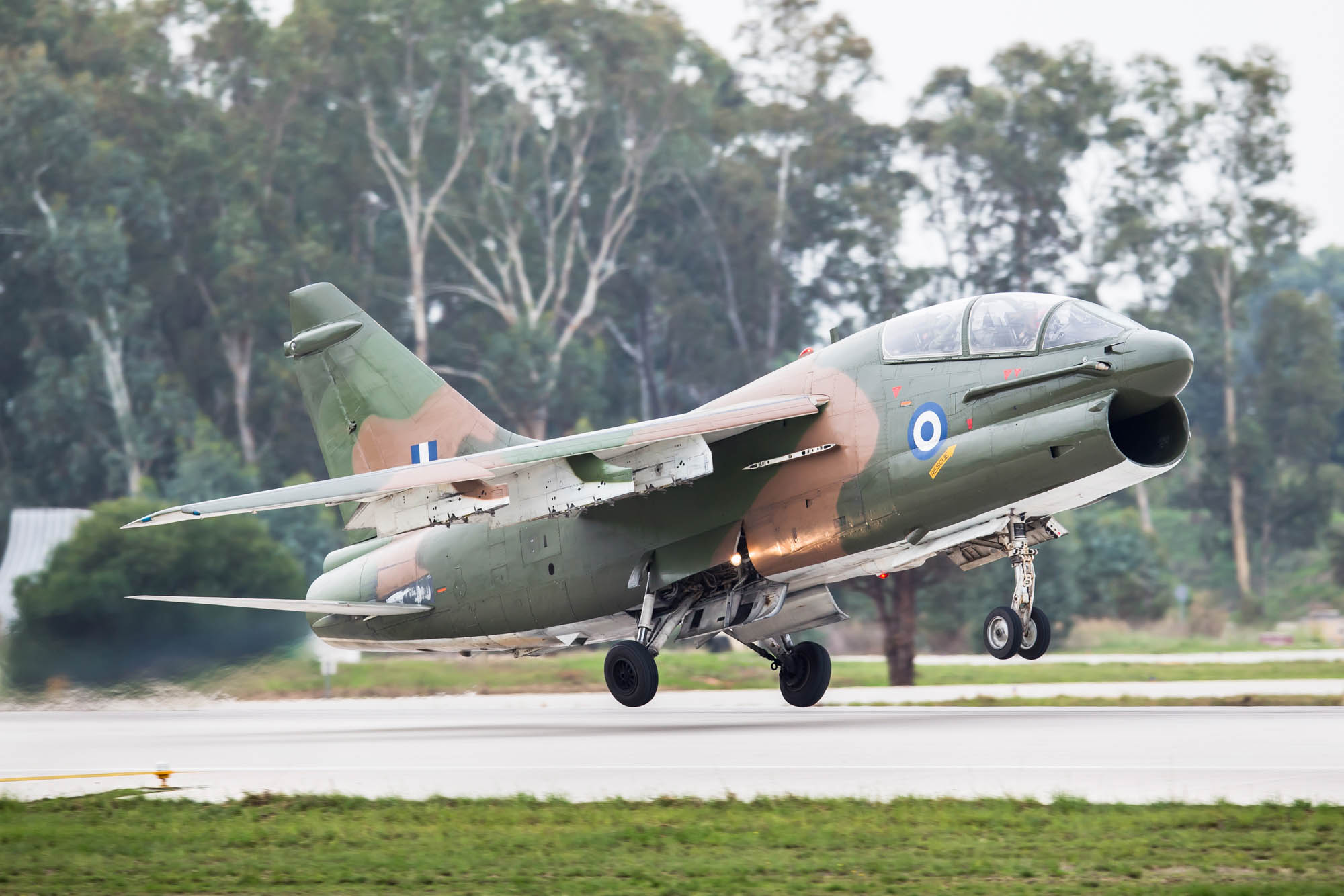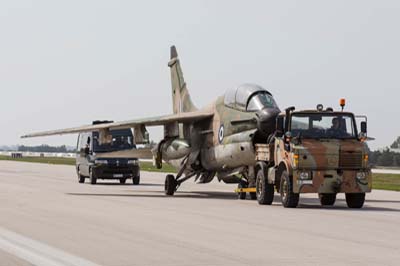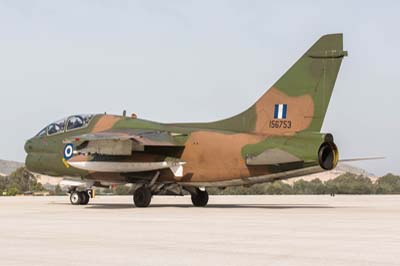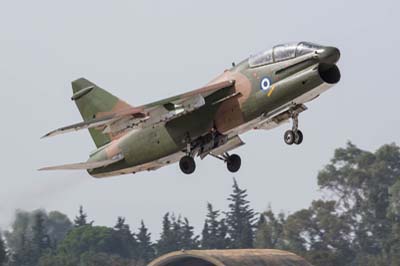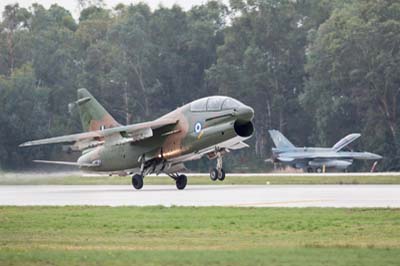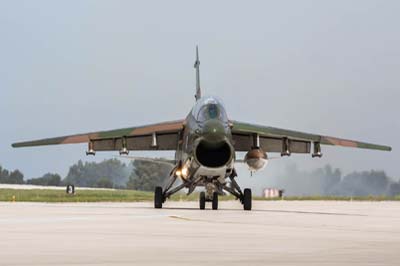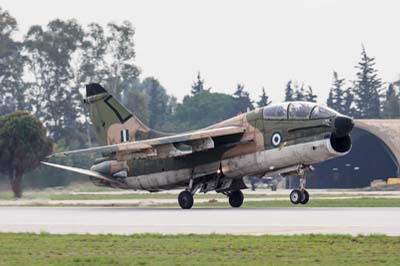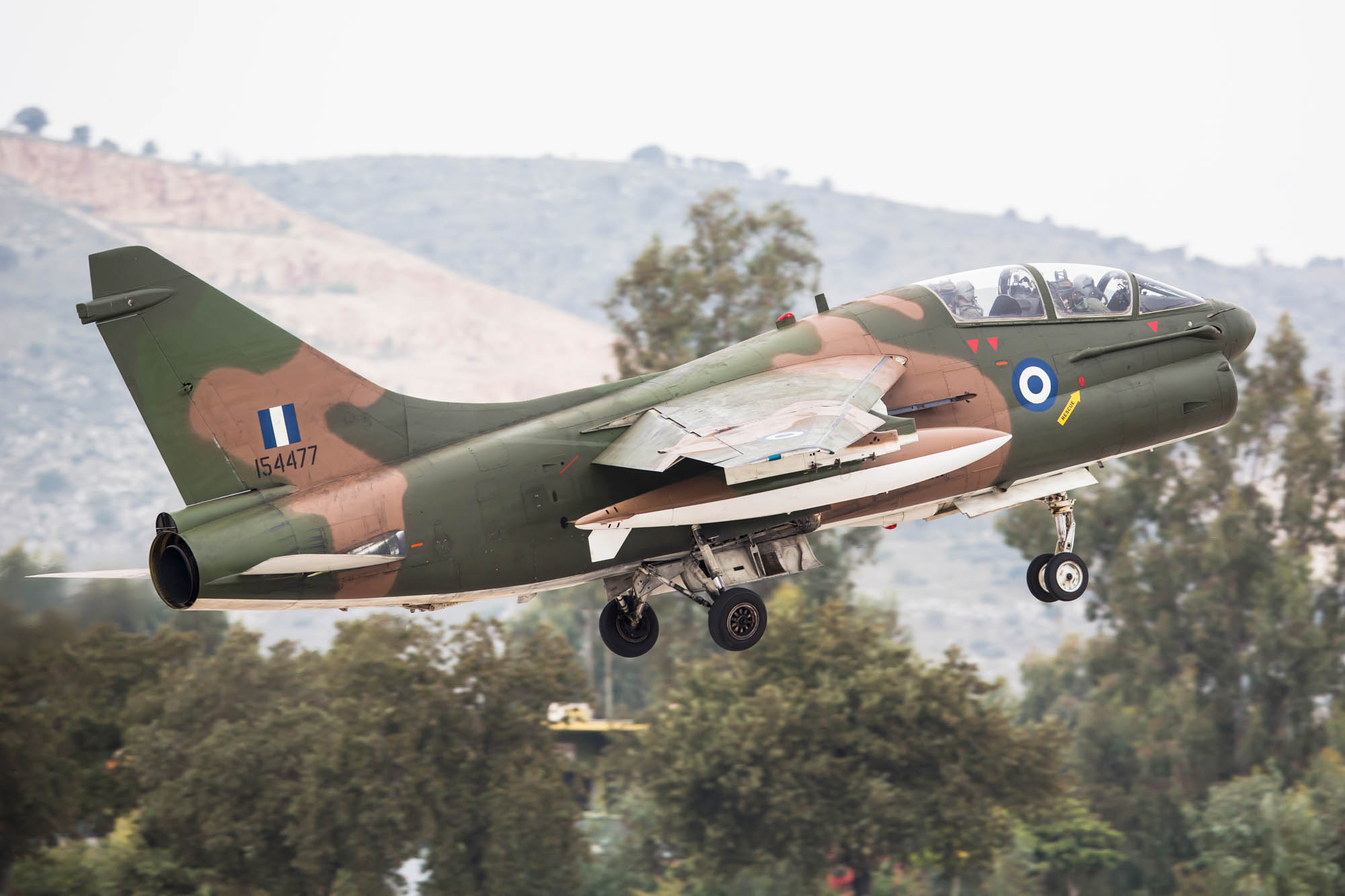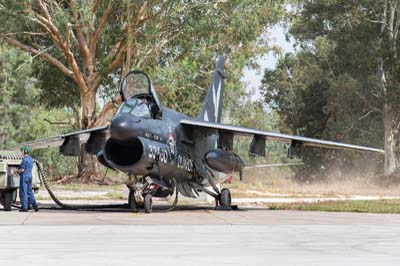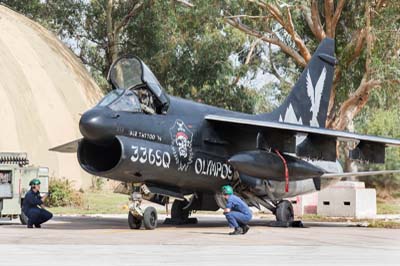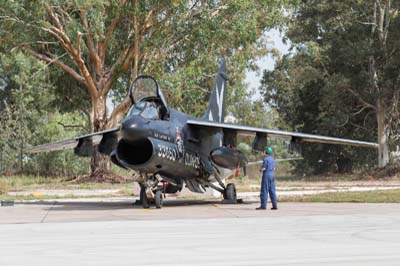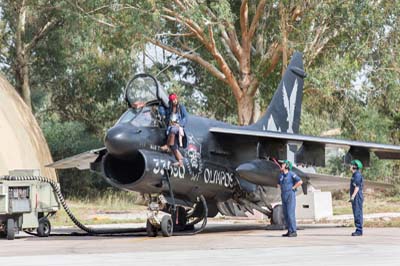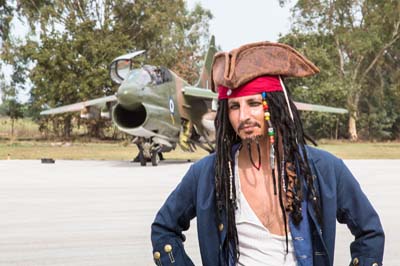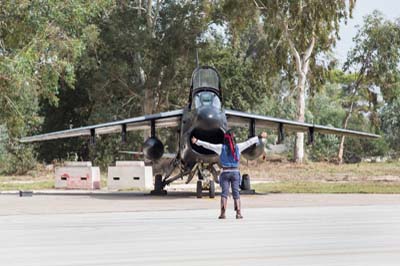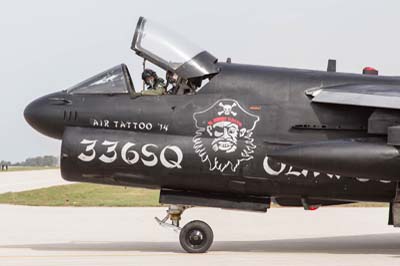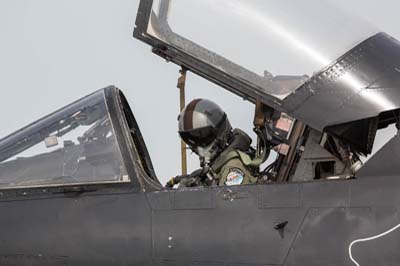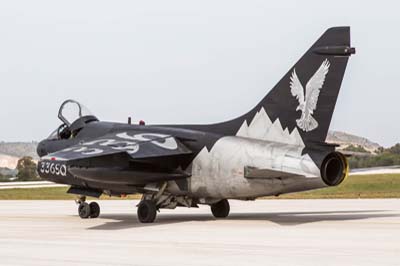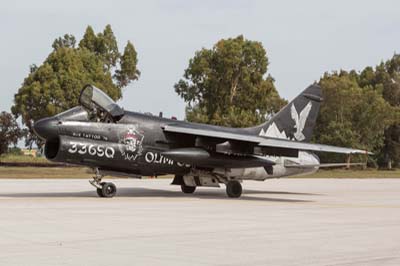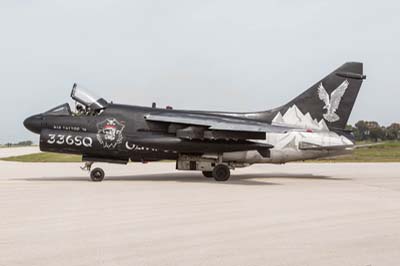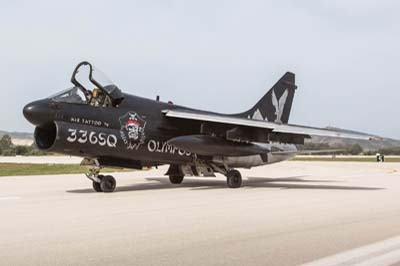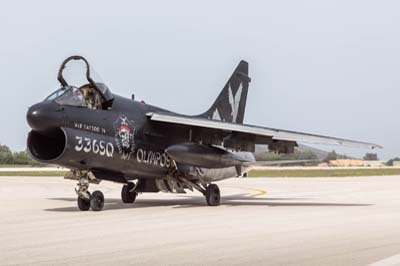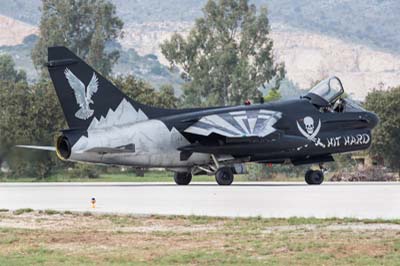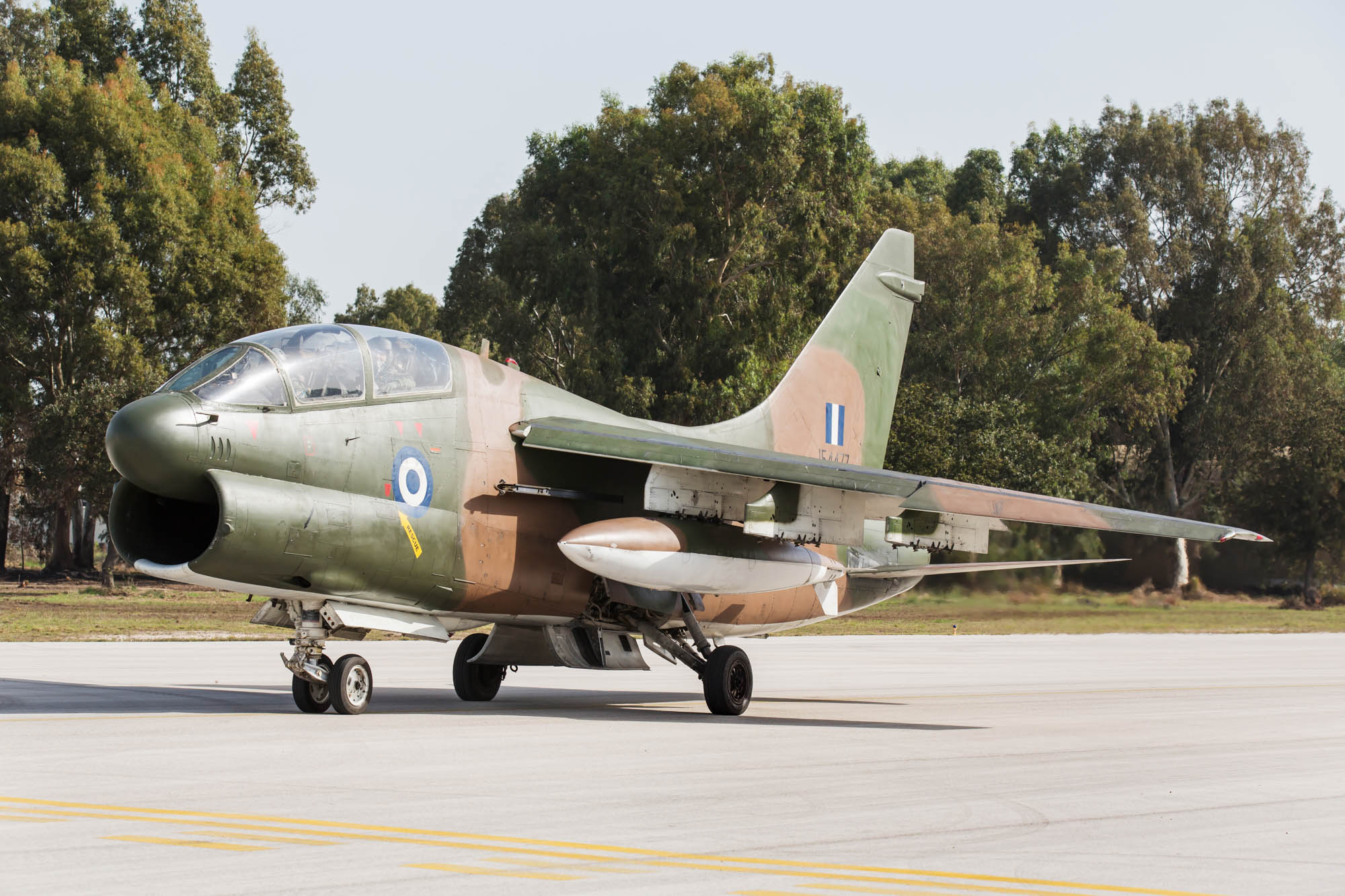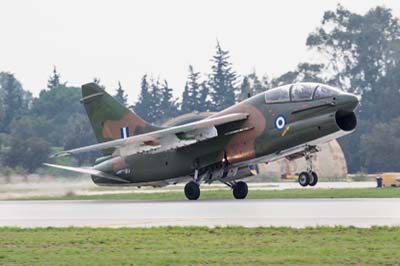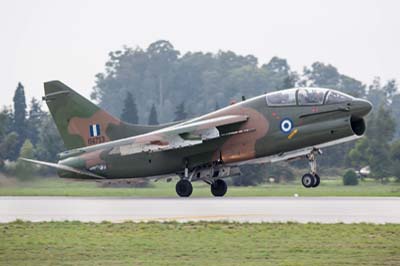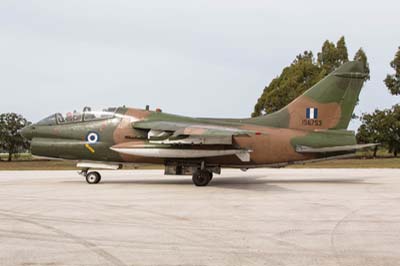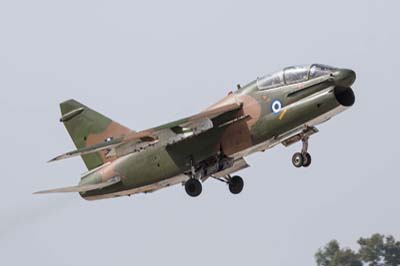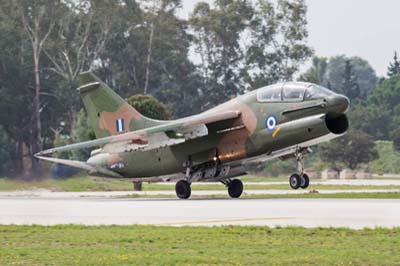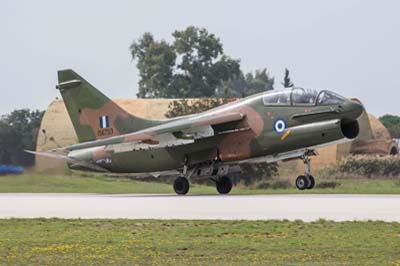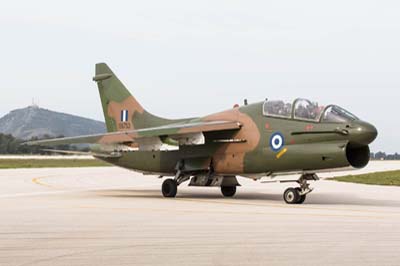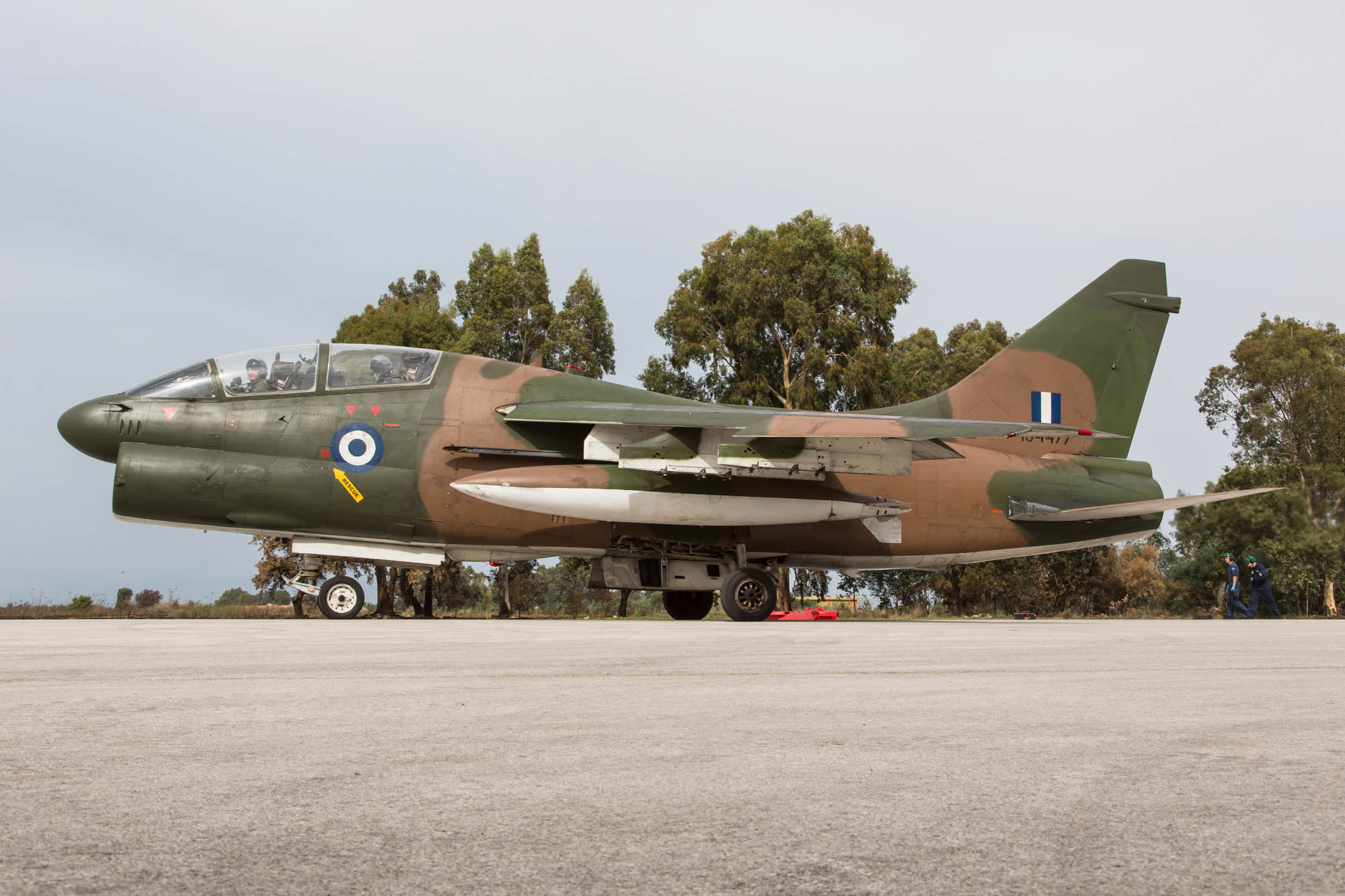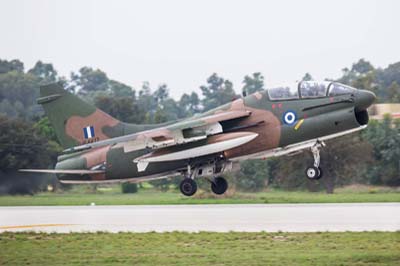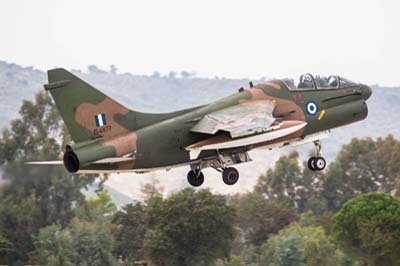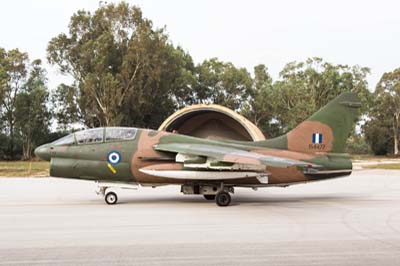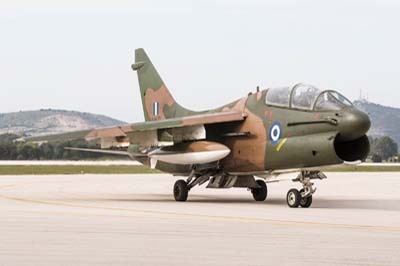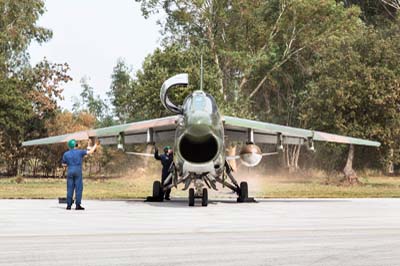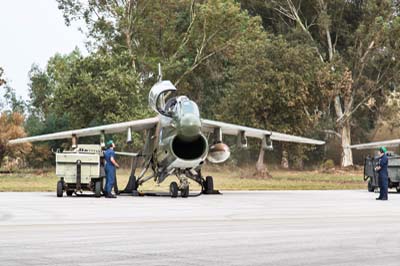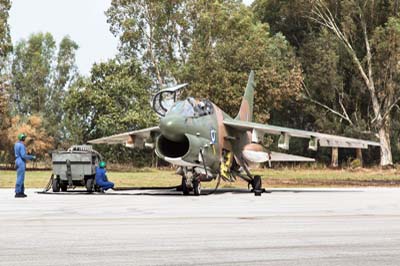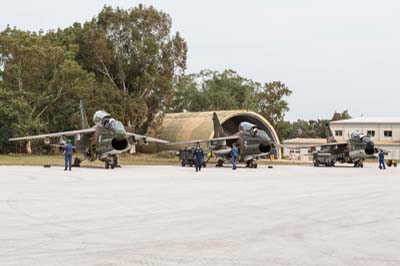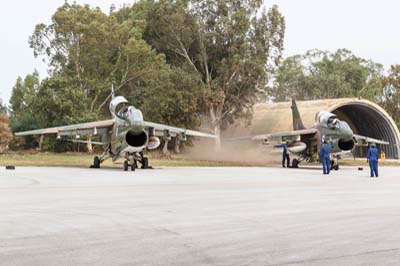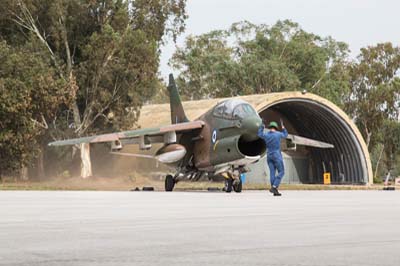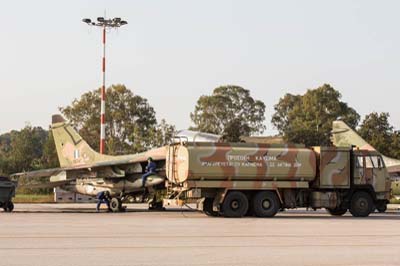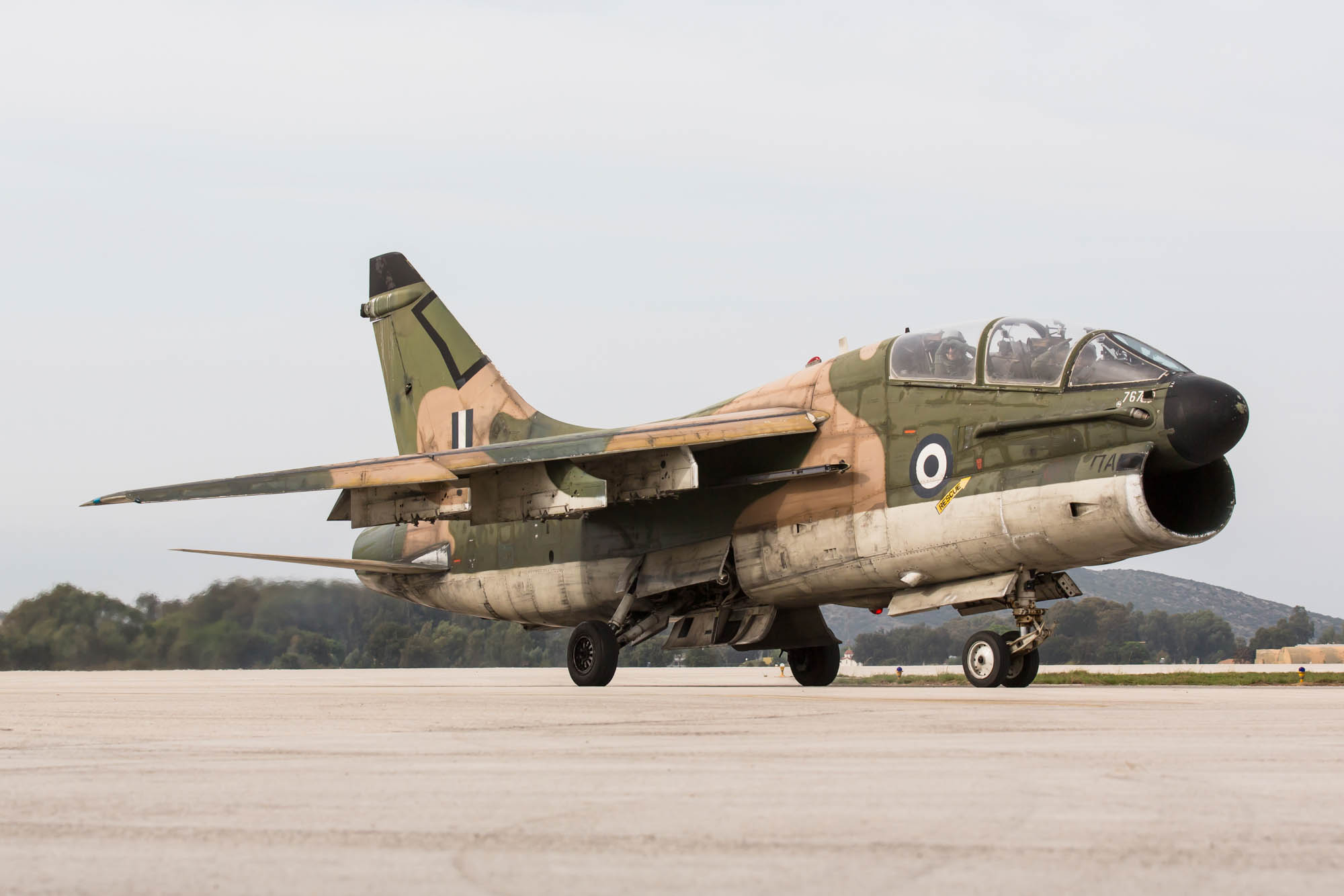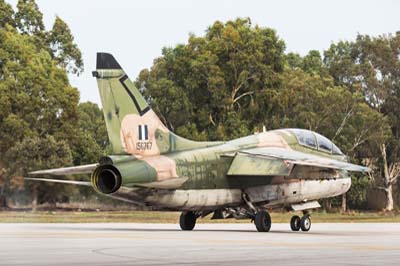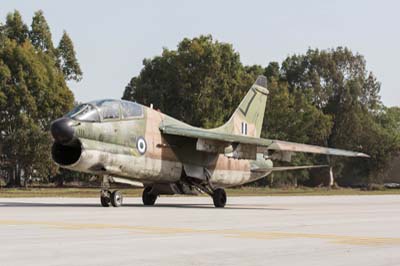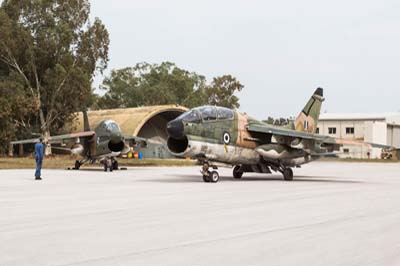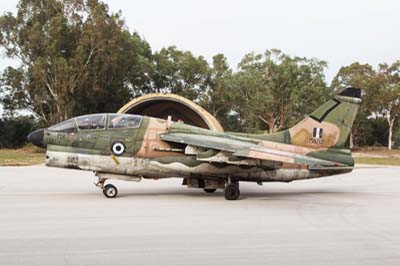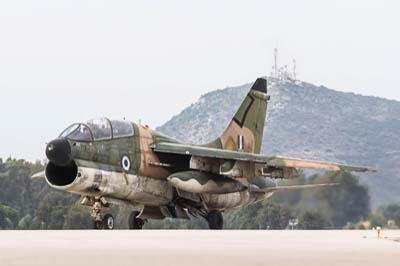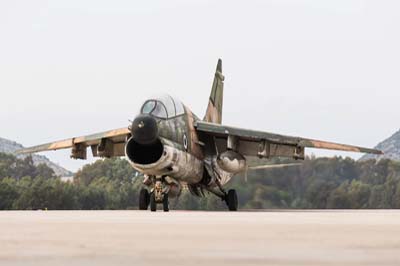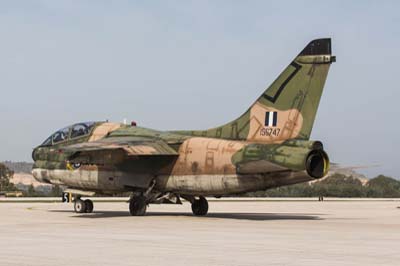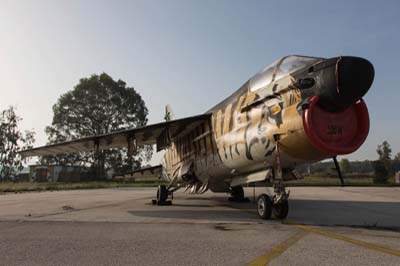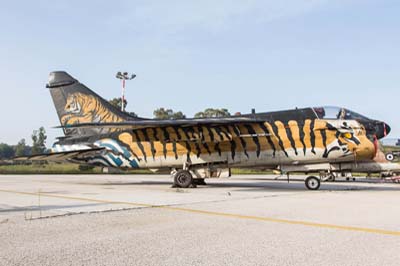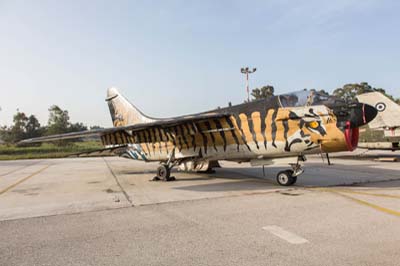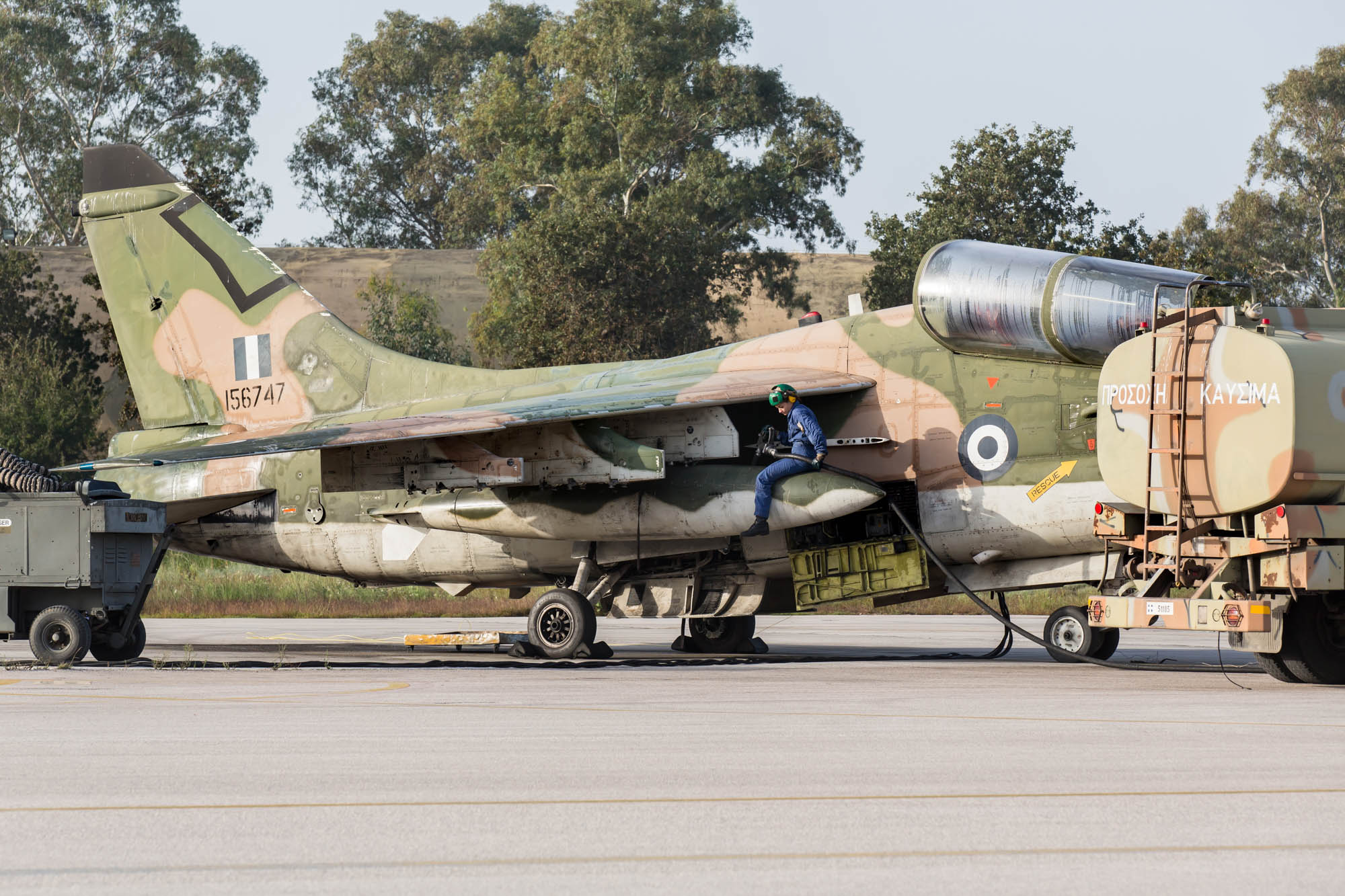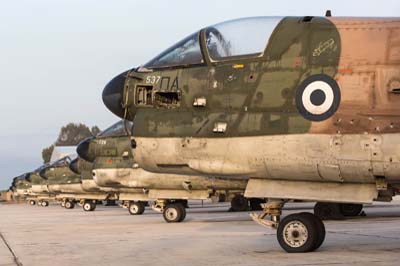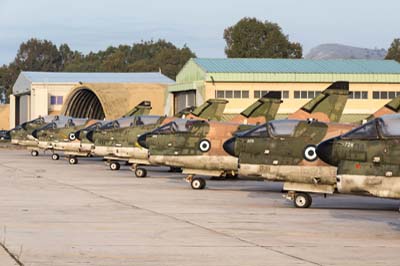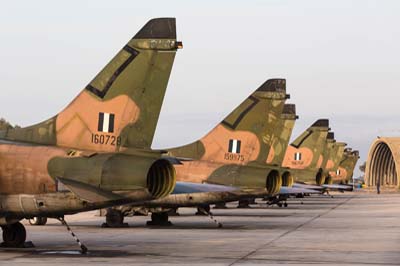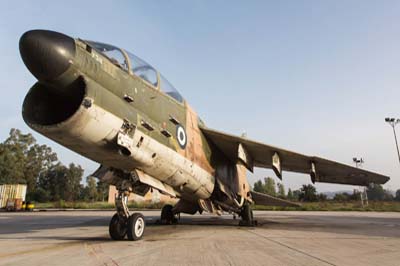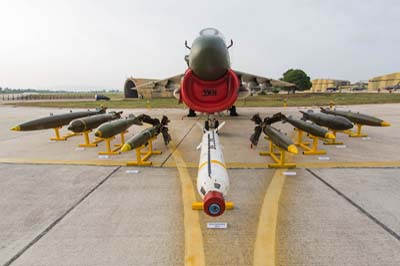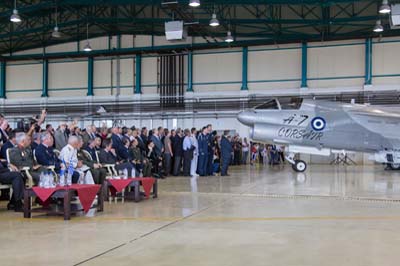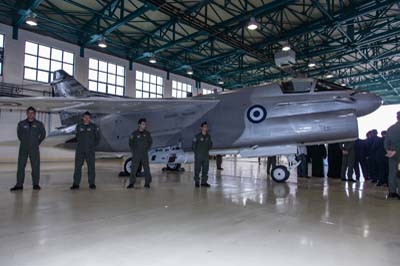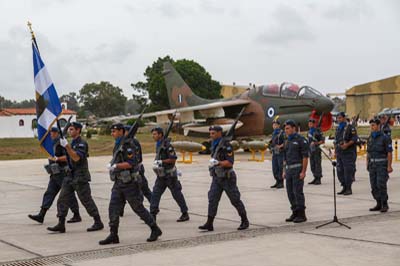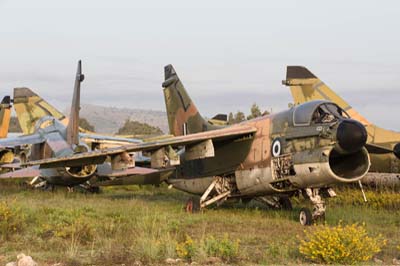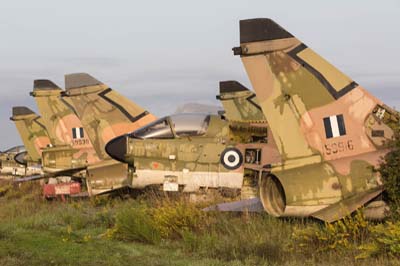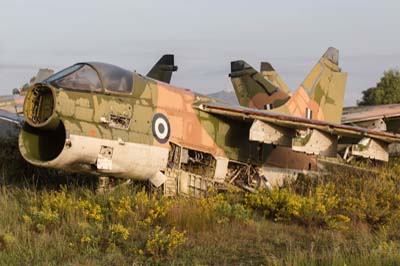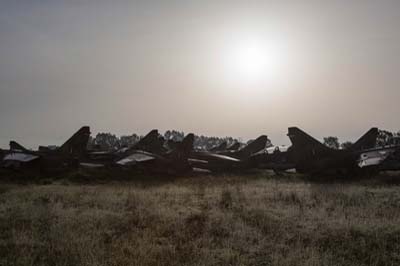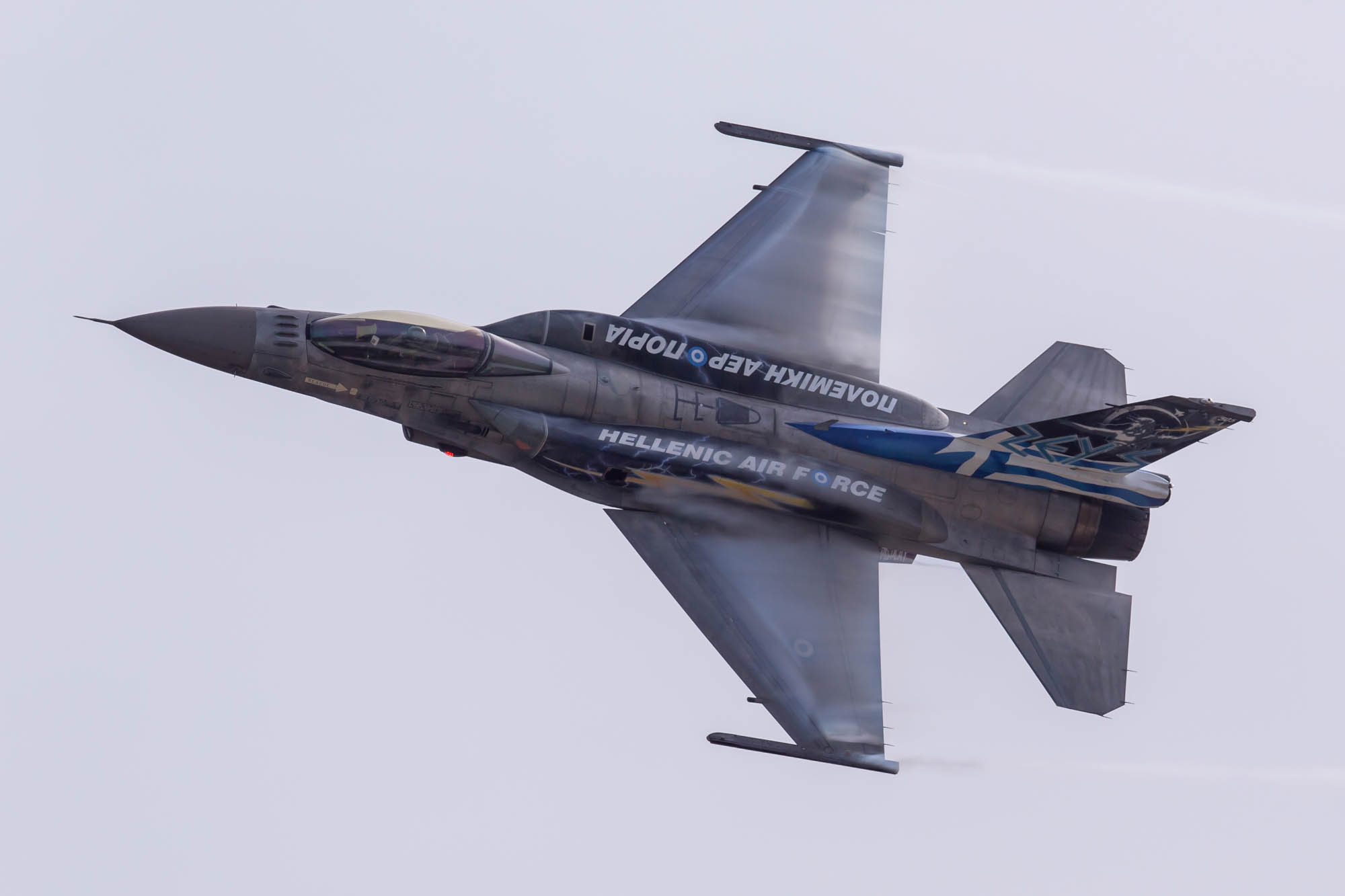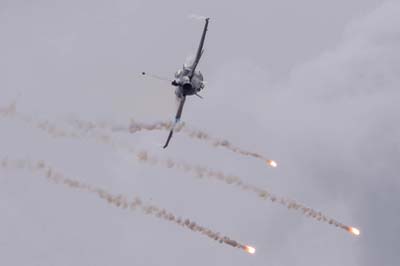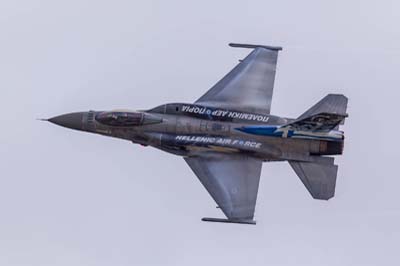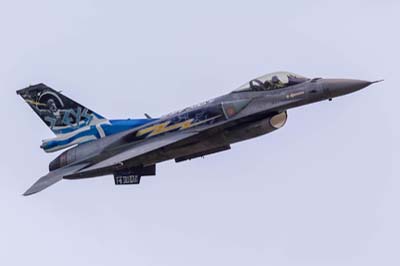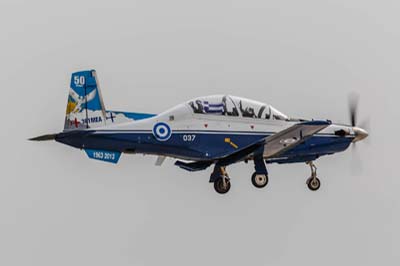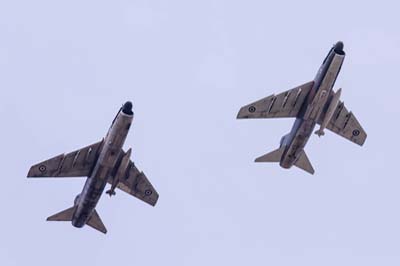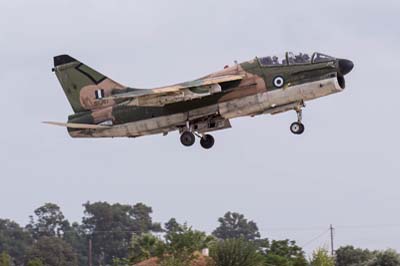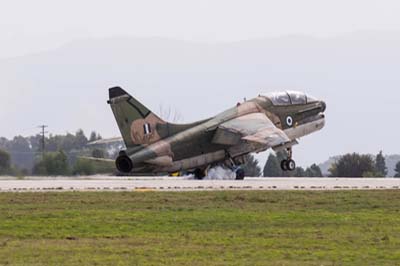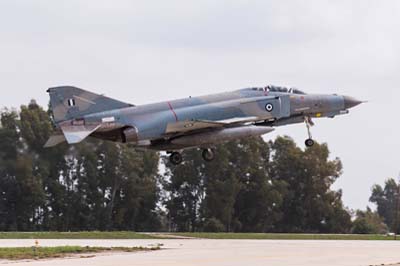Hellenic Air Force - Elliniki Polemiki Aeroporia
A-7 Corsair II Retirement - Fly Low, Hit Hard, Job Done
Araxos Air Force Base, Greece
October 2014
|
| The recently painted TA-7C Corsair II (156753) in an original wrap-around camouflage scheme departing during the media/spotter day for the first of three flights. |
End of an era
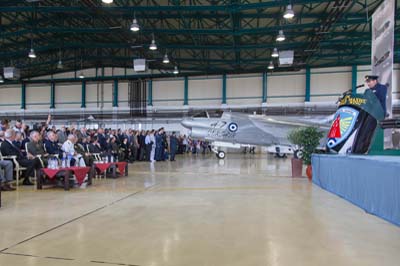 |
The closing ceremony held in the largest hangar on the air base. |
At Araxos air base in Greece on October 17 the Hellenic Air Force (HAF) formally retired their aging fleet of Ling Temco-Vought (LTV) A-7E and the two-seat TA-7C Corsairs IIs. The grand event was attended by the Minister of National Defence, Dimitris Avramopoulos, Lieutenant General Evangelos Tournas, Chief of Hellenic Air Force General Staff, Lieutenant General Christos Vaitsis Chief of the Hellenic Tactical Air Force (HTAF) and other VIPs plus hundreds of senior commanders, officers and pilots past and present. It was obvious by the large attendance that the Corsair was much loved and a highly valued asset of the HAF.
The celebration of the Corsair's 39 year long service with the HAF of a reported 355,000 missions flown and 440,000 flight hours started with a media/spotter event on the day before. The active fleet totalled around 16 A-7E and four two-seat TA-7Cs enthusiasts however were able to inspect and photograph over 60 examples some of which were residing in a dump area, while many others were part of an impressive line-up albeit a few were now without their engines.
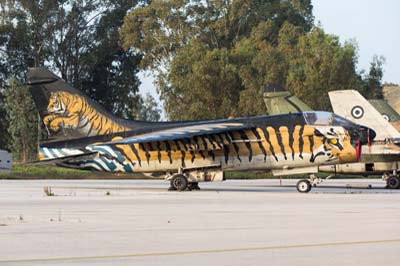 |
A-7E Corsair II (158825) still in its amazing tiger scheme dating back to its time with the now disbanded 335 Mira 'Tiger' Squadron. Both the 335 Mira 'Tiger' and the 336 Mira 'Olympos' jets were flown to Tanágra on October 24 as their final flights. |
336 Mira (Squadron) named 'Olympos' was the last unit in the World to fly this charismatic aircraft and their specially painted silver and black 'Olympos' Corsair with its motto 'Fly Low - Hit Hard' on its starboard side was present. This jet was started up but only to taxi past the photographers and fast-taxi down the runway to its position on the other side of the airfield for the retirement ceremony the following day. Also present was another specially painted aircraft the former 335 Mira 'Tigreis' (Tiger) squadron jet with its beautiful tiger scheme applied before the squadron disbanded six years ago.
For the media/spotter day three two-seat TA-7C Corsairs were fired up alongside the many photographers ready before they taxied out for take-off. Two of these aging jets had been repainted earlier in the year in the original wrap-around South-East Asia camouflage scheme as worn when they were delivered and looked immaculate. However one of these jets for technical reasons failed to launch and was towed back from the end of the runway final check area. The other two took to the air returning 45 minutes later for a fly past, break and landing. Later in the afternoon the same three aircraft repeated the exercise and this time all three made it in to the air. The somewhat tame flypasts were due to the back-seats being occupied by veteran Corsair pilots who had applied in large numbers for a final flight. Those lucky enough to have been chosen by a lottery included a former Vietnam veteran from the United States Navy (USN).
The First Hellenic Corsairs
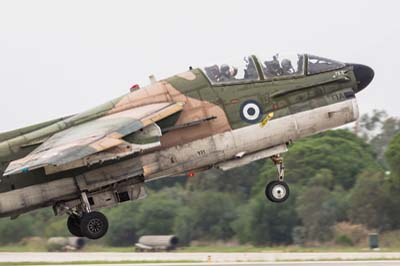 |
One of three TA-7C Corsairs IIs(156767) flown on the media/spotter day, in the backseat is a former A-7 pilot giving the thumbs up who won a lottery to fly. |
Developed in the early 1960s to replace the Chance Vought F-8 Crusader, the LTV A-7 Corsair II first flew in 1965 and two years later saw service in Vietnam with the USN as a carrier-based subsonic light attack aircraft. The more powerful A-7D followed, entering service with the United States Air Force from 1970. The A-7 also flew with the Royal Thai Navy Air Arm (1995-2007) and the Portuguese Air Force (1981-1999) in all 1,500 were built.
Greece emerging from a military junta (1967-74) re-equipped its air force with the purchase of 36 McDonnell Douglas F-4E Phantoms, 40 Dassault Mirage F-1CGs, 40 Rockwell T-2E Buckeye advanced jet trainers and 65 new-build TA-7H/A-7H Corsairs. The first factory fresh A-7H Corsairs arrived in Greece on August 30, 1975 to fulfil the low-level strike mission, a role which the Corsair performed extremely well throughout its long service.
In service with the Hellenic Air Force
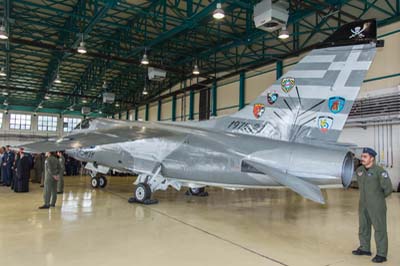 |
The specially painted A-7E Corsair II (159648) just after it was revealed it has all the squadron markings of units who operated the A-7 on the tail and is inscribed under the wing route is; A-7H/TA-7H 1975-2007 320,000 hours and A-7E/TA-7C 1993-2014 120,000 hours and all the serials of the aircraft. |
The A-7H (the 'H' standing for Hellenic) was based on the A-7E but without an air-refuelling capability. They were initially based at Larissa with 347 Mira named 'Perseas' and at Souda with 340 Mira 'Fox' and 345 Mira 'Lailaps'. These original aircraft remained in service till 1997 when the surviving aircraft were put into storage at Agrinio and Tanágra. In 1980 the HAF took delivery of five more two-seat TA-7Hs which were flown until 2007 before they too went into storage.
Between 1992 and 1994 60 A-7Es were acquired along with six TA-7Cs which previously been operated by the USN. Delivered to Araxos air base for 116 Combat Wing they were to replace the Lockheed F-104G Starfighters which were retired in March 1993.
In April 2001 a further six TA-7Cs were added to the fleet, taken from AMARC storage centre in the Arizona desert. In 2002 all the remaining A-7s were transferred to Araxos air base for 335 and 336 Mira. Six years later 335 Mira handed their jets over to their sister squadron to bolster the 336 Mira fleet while some surplus aircraft were put in to open storage. 336 continued to fly the A-7E and TA-7C with the distinction of being the last unit to fly the A-7 Corsair II.
Fly Low, Hit Hard
The A-7 Corsair was one of the first combat aircraft to feature a modern head-up-display (HUD) and an Inertial Navigation System (INS) to assist the pilots. he A-7 has lasted so long due to its ability to perform well ground attack, close air support (CAS) and tactical air support for maritime operations (TASMO).
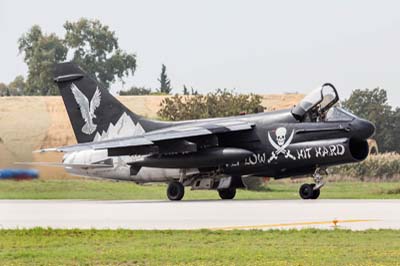 |
The A-7 Corsair's last appearance at RAF Fairford in July this year attracted much interest. 336 Mira's specially painted 'Olympos' aircraft (serial 160616) and its evocative motto 'Fly Low, Hit Hard' painted in a black and silver won the the Concours d'Elegance for the best livery. For the retirement ceremony it could only taxi down the runway. |
The A-7 could conduct in-flight refuelling operations both as receiver and tanker to extend its range. Although lacking some speed when compared to modern jet aircraft fulfilling the same role, its range and payload was comparable to the Lockheed Martin F-16 Fighting Falcon which has gradually forced the Corsair out.
The A-7E has an internally mounted M61A1 20 mm six barrel cannon, six wing pylons and two fuselage launch stations. The pylons can carry a large single weapon, multiple racks capable of six weapons per rack, or triple racks with three weapons per rack. The wing pylons can carry four wing-mounted 300 gallon fuel tanks and a combination of a wide range of general-purpose bombs totalling 15,000 lb (6,800 kg), including; up to 30 500 lb (230 kg) Mark 82 bombs, Paveway Laser-Guided Bombs (LGB), AGM-45 Shrike, AGM-62 Walleye, AGM-65 Maverick, AGM-88 HARM and GBU-15 electro-optical glide bombs. It was reported that Greece also imported over 4,000 CBU-55B cluster bombs between 1970 and 1995. The AFDS (Autonomous Free-flight Dispenser System), containing 16 BLU-108B bomblets was also certified for the A-7. Greece had previously participated in NATO nuclear weapons sharing with the A-7 able to deploy US tactical B.61 nuclear bombs, however by 2001 for strategic reasons these were put into storage. The A-7E was later upgraded to carry the AIM-9L/P Sidewinder for self-protection utilising the two fuselage launch stations.
There was a consensus of commanders and instructors interviewed that the A-7 Corsair pilots were the best low flyers in the HAF. In 2012 the then 336 Mira Commander Lt Col Petez Mittaris, reported that 83% of his squadron's sorties were at low-level, which perhaps explains why Corsair pilots were acknowledged as the best at low-level when compared to their F-16 pilots which spend between 20% and 60% of their flying hours at low-level.
A former A-7 Corsair and F-16 Fighting Falcon pilot Maj Asimakopoulos said his favourite aircraft to fly at low-level was the A-7 Corsair as it was very stable and you can really 'feel' the aircraft; "It's a pilot's aircraft" he said.
Lt Col Theodoros Aivaliotis the current 338 Squadron Commander and an F-4E(AUP) Phantom pilot with 2,000 hours flying experience spoke highly of the A-7 when asked to describe his regular opponent during training exercises he said; "The A-7 is an impressive aircraft, pilot friendly and efficient. I have flown against A-7s many times it was a difficult opponent, agile at low altitude, fuel efficient and can carry a large payload, it was well respected".
|
 |
The final send off
The decommissioning ceremony was held in a large hangar. Following a mass, the 336 Mira Squadron Commander spoke of the supreme service the A-7 Corsair had performed for the HAF. After the unveiling of a specially painted Corsair in an original silver grey scheme depicting all the HAF squadrons that flew it, there followed a speech from the Chief of Hellenic Air Force General Staff and a flypast of two A-7s.
Later there was a small air display which opened with a low apex attack by a formation of three A-7s. After solo displays by a T-6 Texan II and the F-16 Demo Team ‘Zeus’ there was a flypast by a Mirage 2000, F-4E(AUP) Phantom, F-16C Fighting Falcon and TA-7C Corsair in a 'missing man' formation. The Corsair pulled up over the airfield into a vertical climb high out of sight in to the misty clouds signifying its passing into an aircraft heaven. In fact the Corsair will fly a few more times until its final flying event at the annual military parade in Thessalonica for the celebration of the National ‘Oxi’ (No) Day on October 28 to commemorate Greece's entry in World War Two in 1940. When this flight lands at Araxos it will be the end of all A-7 Corsair operations in the World.
336 Mira HAF’s second oldest squadron is to receive half of 335 Mira’s 30 F-16 Block 52+ Fighting Falcons (divided using even serial numbers for 336 Mira) and will continue operations at Araxos. |
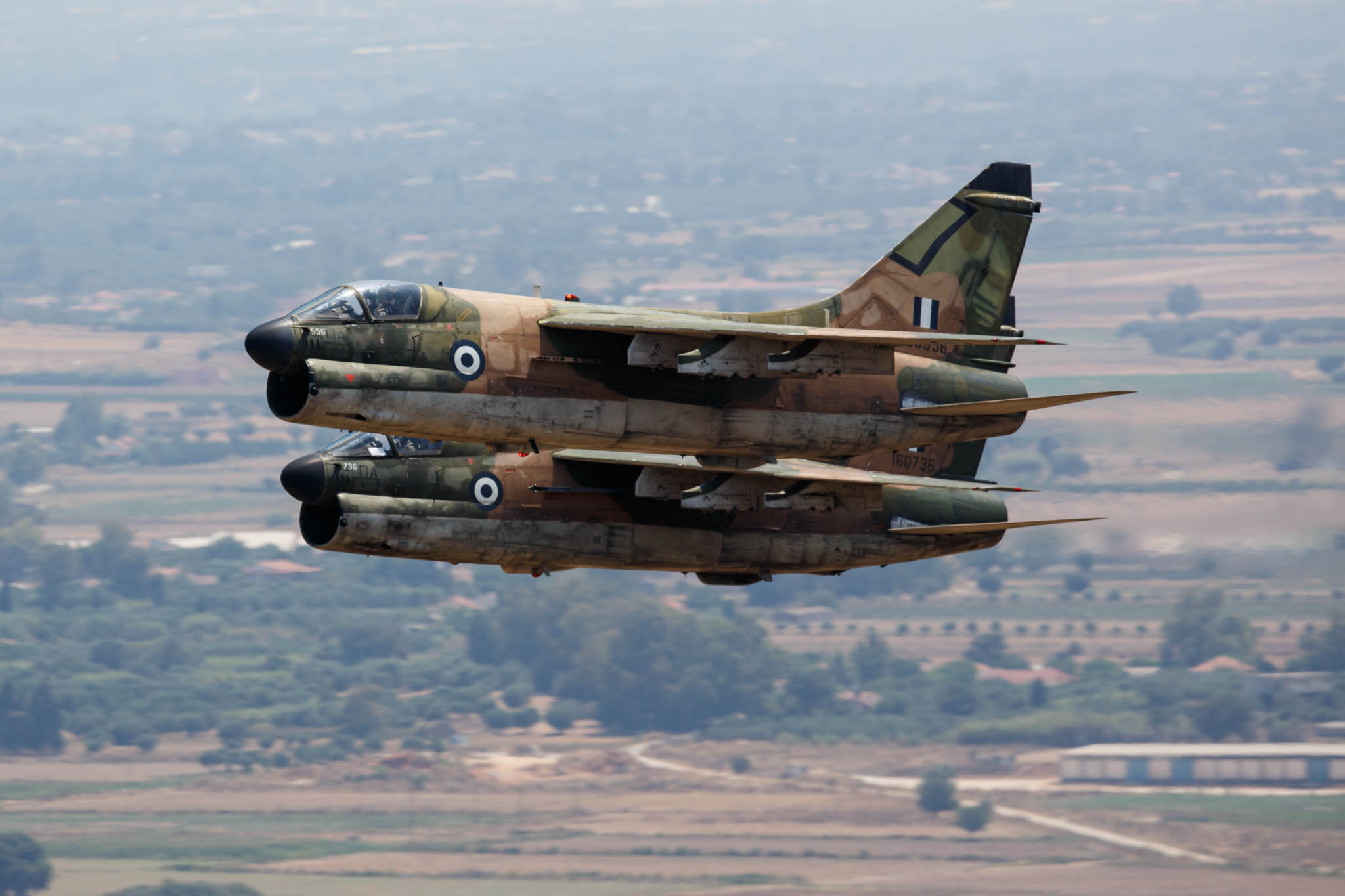 |
A-7E Corsair IIs when with 116 Combat Wing, 336 Mira on a low-level flying training sortie in 2013. At that time 336 Squadron Commander Lt Col Petez Mittaris, reported that 83% of his squadron’s flights were at low-level, a task in which the A-7 excelled and at a time when its pilots were widely regarded as the best low-level flyers in the Hellenic Air Force.
Flying low at 300 feet using its navigation and targeting systems (AN/ AAR-45 LANA (Low-Altitude Night Attack) FLIR (Forward Looking infrared) pod to the target and releasing laser-guided and other smart weapons such as the free-flight dispenser system (AFDS) is what the A-7E Corsair II is all about. The aircraft is strong and reliable which is why its pilots love this aircraft along with its short nose providing the pilot with an unobstructed view essential for flying at low-level. |
| Photo-report from the media/spotter day and from the retirement ceremony held on the following day |
| Left to right: TA-7C Corsair IIs preparing for flight and departing during the media/spotter day. They made three flights each (well almost one went tech' before the first sortie) during the day. The wing pylons can carry four wing-mounted 300 gallon fuel tanks. |
| Left to right: TA-7C Corsair II depart with a 335 Mira F-16C Block 52M Fighting Falcon in the background which will replace the Corsair at 336 Mira. |
| TA-7C Corsair II (154477) in the climb. This jet as been kept in ground running order as was seen in 2025. |
| The specially painted 336 Squadron (Mira) 'Olympos' A-7E Corsair II (160616) did not fly during retirement week but was flown to Tanágra on October 24 as it's final flight. |
| The Olympos Corsair preparing for the second sortie of the day with squadron mascot known as 'George Peiratis' and apparently a member of the groundcrew posing for pictures. |
| 'Olympos' A-7E Corsair II (160616) taxiing out it is inscribed Air Tattoo ’14 from for its appearance at RIAT in July. |
| 'Olympos' A-7E Corsair II (160616). Cockpits are left open during taxing due to lack of an air conditioning system. |
| TA-7C Corsair II (154477) on its way out. |
| Left to right: TA-7C Corsair II (156753). |
| Left to right: TA-7C Corsair II (156753). |
TA-7C Corsair II (154477) holding.
|
| Left to right: TA-7C Corsair II (154477). |
| Left to right: TA-7C Corsairs preparing for the second sortie of the day. |
The A-7E Corsair II is powered by the Allison TF41-A-2 non-afterburning turbofan engine giving it a maximum performance of 600 knots or 690 mph (1,111 km/h) at Sea level.
TA-7C Corsair II (156747) was refuelled early in the morning and is assumed to be the air-spare as it did not fly. |
TA-7C Corsair II (156767) the unpainted well worn of the three two-seats flying on the media/spotter day.
|
| Left to right: TA-7C Corsair II (156767). |
| Left to right: TA-7C Corsair II (156767). |
| Left to right: A-7E Corsair II (158825) is the former 335 Mira ‘Tigreis’ (Tiger) squadron jet and has got to be painted in one of the most attractive tiger schemes. |
| Air-spare for the day TA-7C Corsair II (156747) - the female refuellers loved the Corsair. |
| Left to right: An impressive line-up however some if not all have not flown for some time, with these old aircraft it was not always easy to tell. |
Left to right: Retirement ceremony and outside the hangar.
The A-7E has an internally mounted M61A1 20 mm six barrel cannon, six wing pylons and two fuselage launch stations. The pylons can carry a large single weapon, multiple racks capable of six weapons per rack, or triple racks with three weapons per rack.
The wing pylons can carry four wing-mounted 300 gallon fuel tanks and a combination of a wide range of general-purpose bombs totalling 15,000 lb (6,800 kg), including; up to 30× 500 lb (230 kg) Mark 82 bombs, Paveway Laser-Guided Bombs (LGB), AGM-45 Shrike, AGM-62 Walleye, AGM-65 Maverick, AGM-88 HARM and GBU-15 electro-optical glide bombs. It has been reported that Greece also imported over 4,000 CBU-55B cluster bombs between 1970 and 1995. The AFDS (Autonomous Free-flight Dispenser System), containing 16 BLU-108B bomblets was also certified for the A-7. |
| Left to right: Just a few of the A-7 Corsair held in open storage. |
| Retirement ceremony air show |
HAF F-16 Solo display 'Zeus' (F-16C Fighting Falcon serial 505) with CFTs.
|
| Left to right: F-16C Fighting Falcon (505) of the Zeus F-16 Solo display based at Souda on Crete and the‘Daedalus’ team in a specially marked T-6A Texan II (037) fromf 361 MEA at Kalamata. |
| Left to right: TA-7 Corsair (156767) and F-4E(AUP) Phantom (01528) returning after flypast and display. |
